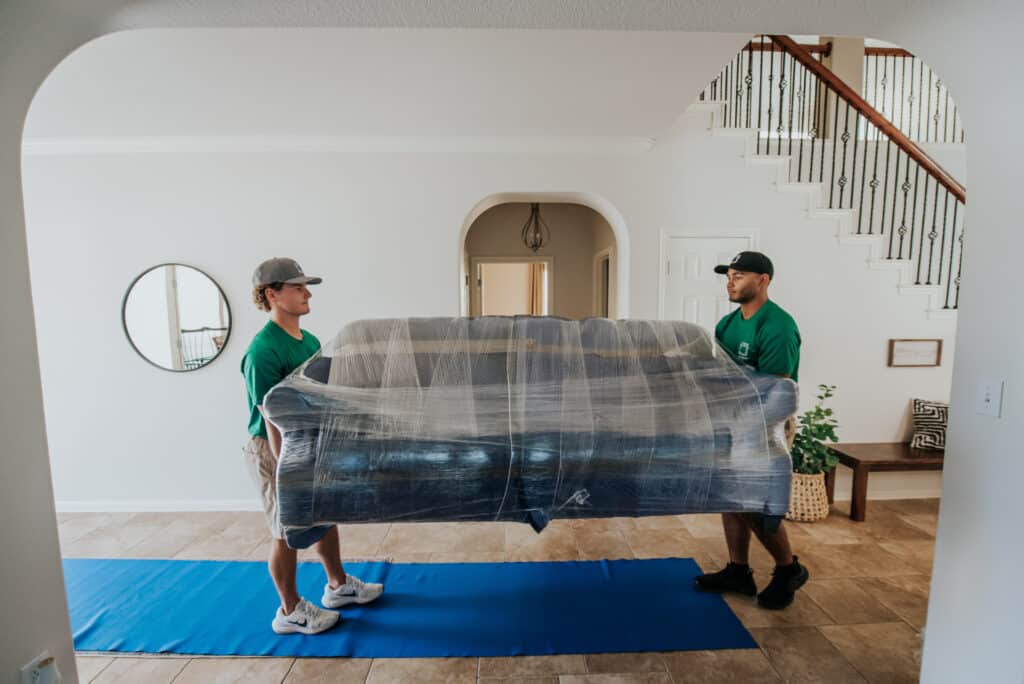Without a solid plan, you might find yourself scrambling in the final moments before your move date. As a moving company, our service includes helping our clients plan their schedules and pack their belongings. We’re helping you create a clear packing timeline for moving to prevent last-minute stress and make your move a smooth, organized experience.
Timeline for Moving to Your New Place
A successful moving timeline starts up to two months before your moving day to research and budget for a moving company, downsize belongings, and organize critical documents. A month before, you can start putting items into boxes and notifying concerned parties. On the week of your move, prepare a “first night” kit and coordinate with your movers for final arrangements.

Use these tips to make a realistic moving timeline that works for your schedule. We can also provide you with a moving checklist to help you remember everything you need in your new home.
1. Two Months Before
Two months before your move date, you’ll get busy with organizing and making important decisions for the big day.
Research Movers
Start your research for reliable movers by looking up reviews, getting quotes, and comparing services. Find a reputable company that fits your budget and specific needs for your move to your new residence.
Set a Moving Budget
Decide on a realistic budget for your moving expenses. Now’s the time to account for packing needs, potential storage costs, and any professional moving services you may need.
Sort and Downsize
Go through your items room by room and sort non-essentials from items you want to keep. Donate, sell, or discard items that will only clutter your new place.
Make a Moving Binder
Create a centralized moving checklist and information hub. This is a great opportunity to file your moving-related documents in one place to stay organized and keep track of important tasks.
Organize Important Documents and Items
Gather and organize critical documents, like school records, medical records, and financial statements. Safeguard small items that can get easily misplaced, like jewelry.
2. Six Weeks Before
During this period, it’s time to prepare your materials, schedule meet-ups, and plan how you can maximize your perishables.
Prepare Packing Materials
Now’s the time to gather packing materials, including a variety of box sizes, tape, and bubble wrap. You can also ask local stores for free boxes to help save on costs.
Strategize Your Meals
Start planning meals to use up perishables and other items from your pantry. This will prevent food waste and lessen the amount of food items you have to move.
Connect With Family and Close Friends
It’s important to spend quality time with your friends and family before you move. Use this time to say goodbye and form lasting memories before the big move.

3. One Month Before
The month before your move involves finalizing logistics and tackling the bulk of the packing as you move to your new home.
Confirm Arrangements With Your Moving Company
Contact the movers to reconfirm the moving data, including the date, time, and final cost estimate. Finalize any last-minute details regarding the number of moving boxes or specific items.
Begin Packing
Start packing and create a detailed inventory of all the boxes. Label each container clearly with its contents and destination room. This is the perfect time to purchase any additional boxes and supplies you need.
Take Care of Paperwork
Gather your medical records to transfer to new healthcare providers, as well as your kids’ school records for their new school. Handle financial paperwork, such as arranging the return of your security deposit from your current landlord. Properly file and sign relevant documents.
Notify Important Entities
Update your address with banks, brokerage firms, and your employer. Notify subscriptions, credit card companies, and insurance providers of your upcoming move to prevent service interruptions.
Check In With Your New Landlord
Submit your change-of-address form with the post office and inform your current landlord of your departure. If renting, connect with your new landlord to confirm move-in details and your new address.
4. Two Weeks Before
About 14 days before your move, you may need to handle final logistical tasks and confirm arrangements for an efficient transition.
Get a Car Tune-Up
Schedule a tune-up for your car to prepare it for a long drive to your new home. This will give you peace of mind that your vehicle is in good condition for the journey. You may also need to clean your vehicle to make room for passengers or boxes.
Contact Your Moving Company
Confirm arrangements for your move day with your moving company. Make sure to check the time and address for pick-up and delivery. This will prevent any miscommunication and give you a chance to sign the paperwork.
Prepare Your Payment Options
Contact your moving company to confirm which forms of payment they accept. Grab some cash and prepare a cashier’s check or credit card to pay for emergency expenses along the way.
5. One Week Before
Seven days before the move is the final push to secure valuables, prepare essentials, and ready your old home for the next occupants.
Safeguard Your Valuables
Carefully set aside valuable items like jewelry, heirloom items, and expensive electronics. They can easily break during the move, so use protective materials like bubble wrap to prevent them from getting damaged or lost during the move.
Prepare a “First Night” Box
Make a separate box with enough clothes you can easily access, toiletries, medications, and other essentials you will need for the first 24-48 hours in your new place.
Return or Give Away Items
Gather and return items to their rightful owners, such as borrowed books, tools, or containers. This also includes returning things to friends and neighbors.
Start Cleaning Spaces
Gather cleaning supplies to make sure you leave the old place in good condition. You could also request professional residential cleaners, especially if you want to save on cleaning materials.
6. Day Before and Moving Day
The day before and moving day are about handling last-minute logistics and working closely with your movers.
Defrost the Freezer
The day before the move is the perfect time to defrost the freezer. This prevents water from leaking and damaging other boxes in the moving truck. Give it enough time to dry out completely.
Double-Check Details
The day before you move, confirm the arrival time and address with the movers. Have a plan for kids and pets to keep them safe and calm on the big day.

Check the Weather
Knowing what to expect ahead of moving day will help you prepare accordingly. Coordinate with your movers on what to do in case of extreme rain or heat forecast.
Do a Final Sweep
Before the movers leave, do a final walkthrough of your old home. Check every closet, cabinet, and drawer to confirm that you haven’t left anything behind. Take a moment to say goodbye and get ready for your new life in your new home.
Moving Timeline Checklist
We’ve been in the moving business long enough to say no two moves are ever exactly alike. We each amass unique collections of items, we have different schedules, and there are different circumstances surrounding a move. However, this table can serve as your starting point.
| Time Left Before the Move | Things to Do |
| 8 weeks | Organize move-related documents, research movers |
| 7 weeks | Sort through your items, set a budget, and pay for services needed for the move |
| 6 weeks | Get packing items, strategize your food consumption |
| 5 weeks | Connect with family and peers, check item or room measurements |
| 4 weeks | Handle paperwork like medical records, notify relevant entities like banks or your insurance company |
| 3 weeks | Pack your stuff, make an inventory |
| 2 weeks | Prepare your car, reconfirm arrangements |
| 1 week | Store valuable items, prepare a “first night box” |
| 1 day | Defrost the freezer, check the weather |
Reminders When Creating a Moving Timeline to Your New Residence
About 92% of Americans faced challenges during their move, with 48% citing stress as the common challenge. When your schedule is off, it can make things much more stressful and even end up costing more money. To help you decide on a timeline, here are some final takeaways.
- Set a hard deadline: Setting a move date early also gives you the ability to line up movers and other service providers well in advance.
- Modify an existing moving checklist/timeline: Make things much quicker and easier by modifying an existing moving checklist.
- Factor in family activities: See if there are any major activities or events that could impact the schedule.
- Don’t forget about the season: Winter and the holidays can slow things down. In the summer, when more people are moving, you may need to choose a professional moving company earlier than expected.
- Use tools that make the job easier: Get some tools to make the move easier, like blankets for lifting or hand truck dollies for moving items. You may also follow our to-do list to speed up the process.
Related Questions
What’s a Good Timeline for Moving?
A good timeline for moving starts two months before your moving day to allow ample time for planning and preparation. Following a structured process from the initial stages to the final day promotes a seamless transition to your new house.
What Is the Average Relocation Timeline?
The average relocation timeline is a multi-stage process, beginning with initial planning and communication, which takes about two to four weeks. The actual relocation, including scheduling the move and arriving at the new residence, typically takes four to six weeks. The final integration can extend for a few months.
How Long Does It Realistically Take to Move?
A small studio apartment move potentially takes a day or two, whereas a larger house could take several days or weeks. The size of your home, the volume of your furniture, and the distance you’re traveling play significant roles in determining how long your move will take.
Conclusion
Get professional help coming up with a realistic moving timeline for your new place! Our moving crew can work with you one-on-one to plot out a schedule that works for your needs. Just give us a call or use the online form to get an instant moving quote.
